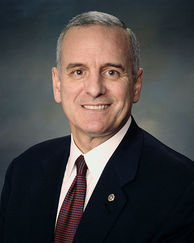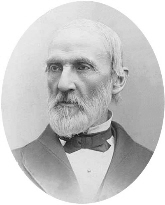Can Dayton Catch Lightning in a Bottle Twice?
Minnesotans have elected a Democratic governor with a Democrat in the White House in just four of 28 cycles since statehood – with none in their second term

At the top of the ballot in Minnesota is Governor Mark Dayton, who might be feeling more confident than most – considering he’s already won at the ballot box with a struggling Obama looming over his campaign (the president had an approval rating of just 45 percent in early November 2010).
That victory by Dayton, as it turns out, was a rare feat in the history of Minnesota elections.
A Smart Politics review of Minnesota election data finds that Democratic gubernatorial candidates have won only four of 28 contests since statehood with a sitting Democratic president in the White House, or 14 percent.
In addition to Dayton’s 2010 win, the only other Democrats to win the governorship of the Gopher State while their party ran the executive branch in Washington D.C. were:
· Henry Sibley in 1857 with James Buchanan in the White House.
· Winfield Hammond in 1914 with Woodrow Wilson at the helm.
· Karl Rolvaag in 1962 with John Kennedy in office.
Governor Dayton has another thing in common with all of these Democrats who can claim such an accomplishment: they were all elected by very narrow margins.
Dayton, of course, escaped the Republican tsunami in 2010 when he won by less than 9,000 votes over Tom Emmer (0.4 points) with 43.6 percent of the vote.

Rolvaag famously defeated incumbent governor Elmer Andersen by 91 votes in a contest that required a drawn-out recount. (Rolvaag did not take office until March 25, 1963).
Hammond, meanwhile, won his race in 1914 with just 45.5 percent of the vote – defeating William Lee by 3.7 points.
And there is another shared point of interest among these four Democrats: Sibley, Hammond, Rolvaag, and Dayton all eked into office when their Democratic president was in his first term with less than two years on the job.
Meanwhile, Minnesota’s Democratic gubernatorial candidates are 0-12 historically when their president is serving in his second term (or greater, with FDR).
Obama – who is already being cast as a lame duck by some in D.C. – will have nearly six years under his belt (creating an increasing list of GOP talking points) when Minnesota voters go to the polls next November.
To be sure, the Republican Party dominated Minnesota politics – including gubernatorial races – for the first several decades until the rise of the Farmer-Labor Party in the 1920s and 1930s.
As such, it should not be surprising the Democratic gubernatorial candidates have a low winning percentage across Minnesota history.
Even still, Democrats have been more than twice as likely to win the governor’s mansion with a Republican in the White House – winning 11 of 37 races, or 30 percent – as they have with a Democrat in D.C. (four of 28 races, 14 percent).
Democrats have also averaged 40.0 percent of the vote with a sitting Republican president in D.C. versus 33.5 percent with a Democratic president.
As for Republicans, the party has won 24 of 37 gubernatorial races with a GOPer in the White House (65 percent) – only slightly lower than when a Democrat is president (20 of 28 races, 71 percent).
Over the last five-plus decades Republicans won the governorship with a Republican president in 1960 (Elmer Andersen, Dwight Eisenhower), 1990 (Arne Carlson, George H.W. Bush), and 2002 and 2006 (Tim Pawlenty, George W. Bush).
As for who will take on Dayton next November – that question just got murkier last month when Marty Seifert entered the crowded six-candidate Republican field.
Follow Smart Politics on Twitter.

Absent a 3rd party challenger of any note and without any controversial amendments on the ballot this coming election should be a clear referendum on Gov. Dayton rather than a contest muddied by external issues and I think he loses.
Whether anyone chooses to admit it or not the stadium funding controversy is certain to take a toll on Dayton’s election hopes. This issue has gone about as sour as it possibly could, something which will affect the candidacies of Republicans as well. I see no possibility of Sen. Rosen entering the race nor is Rep. Zellers likely to continue. Eventually the choice will come down to Rep. Seifert and Sen. Thompson, neither of whom were tainted by the stadium.
With the borrowing repaid to the schools and a possible surplus available for the future there would seem to be fewer hot-button issues for Gov. Dayton to link to his candidacy. He was never the choice of the DFL leadership and would likely not be so now except for his being a sitting governor.
I’m still not convinced Dayton’s in the race for the long haul, particularly if his poll numbers slip further. Should they get down below the mid-forties, just a bit lower than they are now I doubt if he has the stamina to fight a hard race.
If the Republicans run a non-far-right candidate who doesn’t let himself get bogged down in a lot of anti-abortion, anti-gay rhetoric that individual should have an excellent chance of being our next governor.